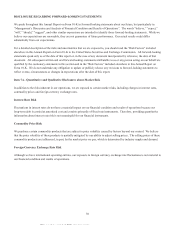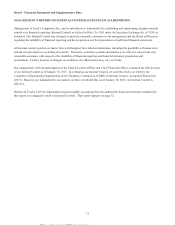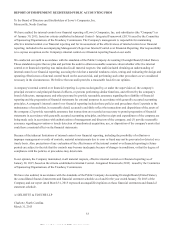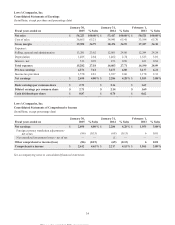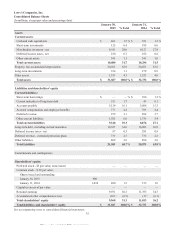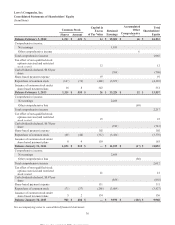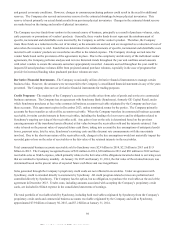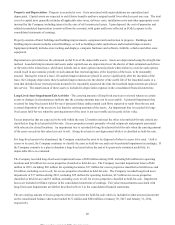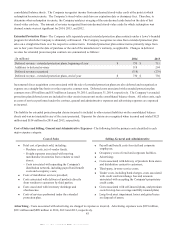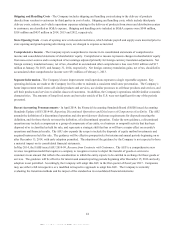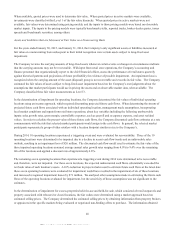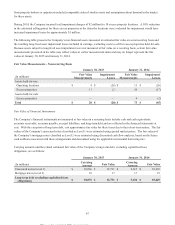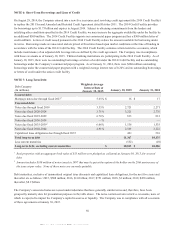Lowe's 2014 Annual Report Download - page 50
Download and view the complete annual report
Please find page 50 of the 2014 Lowe's annual report below. You can navigate through the pages in the report by either clicking on the pages listed below, or by using the keyword search tool below to find specific information within the annual report.Property and Depreciation - Property is recorded at cost. Costs associated with major additions are capitalized and
depreciated. Capital assets are expected to yield future benefits and have original useful lives which exceed one year. The total
cost of a capital asset generally includes all applicable sales taxes, delivery costs, installation costs and other appropriate costs
incurred by the Company, including interest in the case of self-constructed assets. Upon disposal, the cost of properties and
related accumulated depreciation is removed from the accounts, with gains and losses reflected in SG&A expense in the
consolidated statements of earnings.
Property consists of land, buildings and building improvements, equipment and construction in progress. Buildings and
building improvements includes owned buildings, as well as buildings under capital lease and leasehold improvements.
Equipment primarily includes store racking and displays, computer hardware and software, forklifts, vehicles and other store
equipment.
Depreciation is provided over the estimated useful lives of the depreciable assets. Assets are depreciated using the straight-line
method. Leasehold improvements and assets under capital lease are depreciated over the shorter of their estimated useful lives
or the term of the related lease, which may include one or more option renewal periods where failure to exercise such options
would result in an economic penalty in such amount that renewal appears, at the inception of the lease, to be reasonably
assured. During the term of a lease, if leasehold improvements are placed in service significantly after the inception of the
lease, the Company depreciates these leasehold improvements over the shorter of the useful life of the leasehold assets or a
term that includes lease renewal periods deemed to be reasonably assured at the time the leasehold improvements are placed
into service. The amortization of these assets is included in depreciation expense in the consolidated financial statements.
Long-Lived Asset Impairment/Exit Activities - The carrying amounts of long-lived assets are reviewed whenever certain
events or changes in circumstances indicate that the carrying amounts may not be recoverable. A potential impairment has
occurred for long-lived assets held-for-use if projected future undiscounted cash flows expected to result from the use and
eventual disposition of the assets are less than the carrying amounts of the assets. An impairment loss is recorded for long-
lived assets held-for-use when the carrying amount of the asset is not recoverable and exceeds its fair value.
Excess properties that are expected to be sold within the next 12 months and meet the other relevant held-for-sale criteria are
classified as long-lived assets held-for-sale. Excess properties consist primarily of retail outparcels and property associated
with relocated or closed locations. An impairment loss is recorded for long-lived assets held-for-sale when the carrying amount
of the asset exceeds its fair value less cost to sell. A long-lived asset is not depreciated while it is classified as held-for-sale.
For long-lived assets to be abandoned, the Company considers the asset to be disposed of when it ceases to be used. Until it
ceases to be used, the Company continues to classify the asset as held-for-use and tests for potential impairment accordingly. If
the Company commits to a plan to abandon a long-lived asset before the end of its previously estimated useful life, its
depreciable life is re-evaluated.
The Company recorded long-lived asset impairment losses of $28 million during 2014, including $26 million for operating
locations and $2 million for excess properties classified as held-for-use. The Company recorded impairment losses of $46
million in 2013, including $26 million for operating locations, $17 million for excess properties classified as held-for-use and
$3 million, including costs to sell, for excess properties classified as held-for-sale. The Company recorded long-lived asset
impairment of $77 million during 2012, including $55 million for operating locations, $17 million for excess properties
classified as held-for-use and $5 million, including costs to sell, for excess properties classified as held-for-sale. Impairment
losses are included in SG&A expense in the consolidated statements of earnings. Fair value measurements associated with
long-lived asset impairments are further described in Note 2 to the consolidated financial statements.
The net carrying amount of excess properties that do not meet the held-for-sale criteria is included in other assets (noncurrent)
on the consolidated balance sheets and totaled $152 million and $204 million at January 30, 2015 and January 31, 2014,
respectively.
40
This proof is printed at 96% of original size
This line represents final trim and will not print


